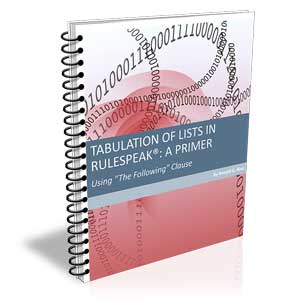Object Management Group Adopts Date-Time Vocabulary Beta Specification
At its recent September 2011 Technical Meeting, the Architecture Board of the Object Management Group adopted the "Date-Time Vocabulary" submission as an OMG Beta Specification.[1]
Many SBVR (the OMG's "Semantics of Business Vocabulary and Business Rules" specification) rules involve common, generic, cross-domain concepts in subject fields such as Date and Time; Quantities, Scales, and Units of Measures; Locations; and Whole-Part Structures. Characteristics of such concepts are frequent usage in everyday and business activities and wide usage across all business domains such as finance and manufacturing.
SBVR tool vendors and users need standard vocabularies for such concepts to improve interoperability among vendors and to ensure that they share the same concepts in the same ways. Vendors also need an agreed format for exchange of date and time literals when used in rules. The SBVR community in general needs such vocabularies as a foundation to avoid the start-up cost of defining vocabularies for basic concepts, and as an example for interoperability testing among tools. The OMG sees value of the Date-Time Vocabulary and other subsequent OMG foundation vocabularies in lowering the "cost of entry" for potential SBVR users.
The Date-Time vocabulary specification addresses two different, but complementary, aspects of time:
- Temporal concepts:
- Temporal noun concepts (such as time coordinate, duration, calendar, etc.), and
- Temporal verb concepts (such as time coordinate is in the past, time
interval1
is before time
interval2, time interval1 includes time interval2, etc.) that model relationships between temporal noun concepts.
- Verb Concepts that relate situation models and occurrences (such as a person being married to another person) to temporal concepts (e.g., to a time interval).
These two aspects reflect the use/mention distinction well known from analytical philosophy: the first mentions temporal concepts, whereas the second uses temporal concepts in order to anchor situation models and occurrences in time.
The OMG's Model Driven Architecture (MDA) anticipates mappings between business-layer or Computation Independent Models (CIM) and implementation-layer Platform Independent (PIM) and Platform Specific (PSM) Models. To encourage such mappings, this document provides date and time models in UML plus OCL, partially in CLIF, and partially in OWL modeled in ODM. The UML, CLIF, and OWL/ODM date and time models are "equivalent" to the SBVR date and time vocabulary while being "true" to the spirit of their respective technologies.
The Date-Time Vocabulary specification attempts to satisfy several goals that tend to conflict.
- Provide a standard business vocabulary for Date and Time Concepts that business users can share and exploit in their business domain vocabularies and rules. This requires an "...SBVR Foundation Business Terminology that is conceptualized optimally for the way people think and communicate about things in their organizations using natural language." To satisfy this goal, the date and time vocabulary needs to include terms that make intuitive sense to business users.
- Support Machine Reasoning about Time by providing a formal ontology that enables machine interpretation and reasoning. This means that processing by automated reasoners is possible, based on a well-grounded formal representation. For example, it should be possible for a reasoning system to determine whether a payment is more than 30 days late compared to some due date. Satisfying this goal requires carefully-defined vocabulary concepts, to the point of making distinctions that would not occur to business users. The business vocabulary is grounded on the formal ontology, so these distinctions show through in the business vocabulary.
- Enable implementation by enabling tool vendors and other software developers to implement the date and time vocabulary with a "reasonable" amount of development effort — meaning that the value obtained is commensurate with the development cost. That cost is driven by the size of the vocabulary — the more there is to implement, the greater the cost. Implementation cost is also driven by the effort required to resolve ambiguities, omissions, and inconsistencies in the specification. Including a formal grounding and concise vocabulary is expected to facilitate both development of tools and use of the specification by vendors, business users, and those who want to apply formal reasoning systems.
The Date-Time Vocabulary specification employs several techniques to reconcile these different modeling goals. The vocabulary is presented as an SBVR business vocabulary, with extensive examples and notes. Many formally-defined concepts are also presented in CLIF and OCL. Wherever possible, terms and examples are chosen to make sense to business users. Parallel construction of terms ensures that related terms are used consistently. Every concept is precisely defined. Multiple distinct concepts are defined where needed to distinguish between concepts that are intuitively similar but have different reasoning implications. Annex D ("Foundational Concepts") documents general concepts that, though out-of-scope for a date and time vocabulary, nevertheless must be implemented consistently by reasoning systems.
Implementers and reasoning systems are also addressed by providing this date and time vocabulary in SBVR, UML, and CLIF forms.
The OMG Date-Time Vocabulary Finalization Task Force will begin working immediately resolving Issues open at the time of adoption, including the full alignment to the SBVR specification, and new Issues that arise in the course of vendors implementing the specification. Anyone may submit an Issue regarding the Date-Time Specification on the OMG website.[2]References
[1] The "Date-Time Vocabulary" submission as an OMG Beta Specification is available at: http://www.omg.org/cgi-bin/doc?bmi/2011-08-01![]()
[2] Submit an Issue regarding the Date-Time Specification on the OMG website at: http://www.omg.org/technology/agreement.htm ![]()
# # #
About our Contributor:
Online Interactive Training Series
In response to a great many requests, Business Rule Solutions now offers at-a-distance learning options. No travel, no backlogs, no hassles. Same great instructors, but with schedules, content and pricing designed to meet the special needs of busy professionals.













